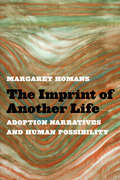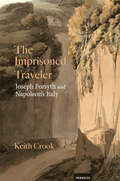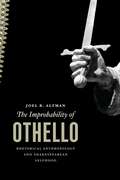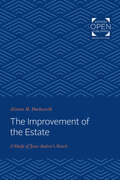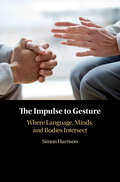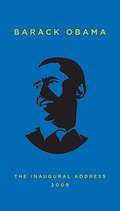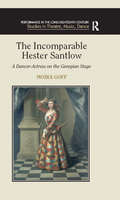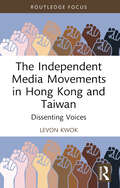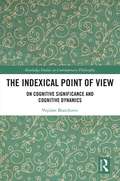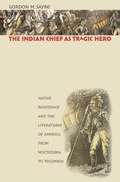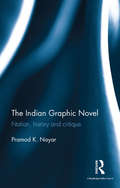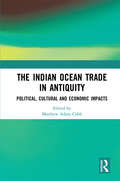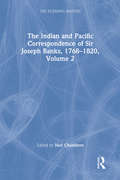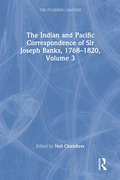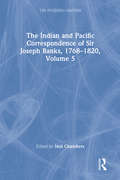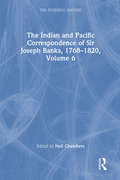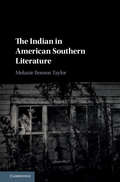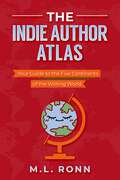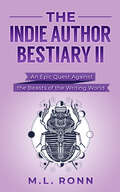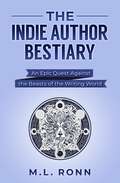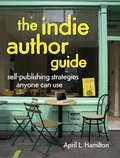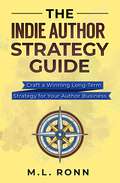- Table View
- List View
The Imprint of Another Life: Adoption Narratives and Human Possibility
by Margaret HomansThe Imprint of Another Life: Adoption Narratives and Human Possibility addresses a series of questions about common beliefs about adoption. Underlying these beliefs is the assumption that human qualities are innate and intrinsic, an assumption often held by adoptees and their families, sometimes at great emotional cost. This book explores representations of adoption—transracial, transnational, and domestic same-race adoption—that reimagine human possibility by questioning this assumption and conceiving of alternatives. Literary scholar Margaret Homans examines fiction making’s special relationship to themes of adoption, an “as if” form of family making, fabricated or fictional instead of biological or “real. ” Adoption has tended to generate stories rather than uncover bedrock truths. Adoptive families are made, not born; in the words of novelist Jeanette Winterson, “adopted children are self-invented because we have to be. ” In attempting to recover their lost histories and identities, adoptees create new stories about themselves. While some believe that adoptees cannot be whole unless they reconnect with their origins, others believe that privileging biology reaffirms hierarchies (such as those of race) that harm societies and individuals. Adoption is lived and represented through an irresolvable tension between belief in the innate nature of human traits and belief in their constructedness, contingency, and changeability. The book shows some of the ways in which literary creation, and a concept of adoption as a form of creativity, manages this tension. The texts examined include fiction (e. g. , classic novels such as Silas Marner, What Maisie Knew, and Beloved); memoirs by adoptees, adoptive parents, and birthmothers; drama, documentary films, advice manuals, social science writing; and published interviews with adoptees, parents, and birth parents. Along the way the book tracks the quests of adoptees who, whether or not they meet their original families, must construct their own stories rather than finding them; follows transnational adoptees as they return, hopes held high, to Korea and China; looks over the shoulders of a generation of girls adopted from China as they watch Disney’s iconic Mulan, with its alluring story of destiny written on the skin; and listens to birthmothers as they struggle to tell painful secrets held for decades. This book engages in debates within adoption studies, women’s and gender studies, transnational studies, and ethnic studies; it will appeal to literary scholars and critics, including specialists in memoir or narrative theory, and to general readers interested in adoption and in race.
The Imprisoned Traveler: Joseph Forsyth and Napoleon's Italy (Transits: Literature, Thought & Culture 1650-1850)
by Keith CrookThe Imprisoned Traveler is a fascinating portrait of a unique book, its context, and its elusive author. Joseph Forsyth, traveling through an Italy plundered by Napoleon, was unjustly imprisoned in 1803 by the French as an enemy alien. Out of his arduous eleven-year “detention” came his only book, Remarks on Antiquities, Arts, and Letters during an Excursion in Italy (1813). Written as an (unsuccessful) appeal for release, praised by Forsyth’s contemporaries for its originality and fine taste, it is now recognized as a classic of Romantic period travel writing. Keith Crook, in this authoritative study, evokes the peculiar miseries that Forsyth endured in French prisons, reveals the significance of Forsyth’s encounters with scientists, poets, scholars, and ordinary Italians, and analyzes his judgments on Italian artworks. He uncovers how Forsyth’s allusiveness functions as a method of covert protest against Napoleon and reproduces the hitherto unpublished correspondence between the imprisoned Forsyth and his brother. Published by Bucknell University Press. Distributed worldwide by Rutgers University Press.
The Improbability of Othello: Rhetorical Anthropology and Shakespearean Selfhood
by Joel B. AltmanShakespeare’s dramatis personae exist in a world of supposition, struggling to connect knowledge that cannot be had, judgments that must be made, and actions that need to be taken. For them, probability—what they and others might be persuaded to believe—governs human affairs, not certainty. Yet negotiating the space of probability is fraught with difficulty. Here, Joel B. Altman explores the problematics of probability and the psychology of persuasion in Renaissance rhetoric and Shakespeare’s theater.Focusing on the Tragedy of Othello, Altman investigates Shakespeare’s representation of the self as a specific realization of tensions pervading the rhetorical culture in which he was educated and practiced his craft. In Altman’s account, Shakespeare also restrains and energizes his audiences’ probabilizing capacities, alternately playing the skeptical critic and dramaturgic trickster. A monumental work of scholarship by one of America’s most respected scholars of Renaissance literature, The Improbability of Othello contributes fresh ideas to our understanding of Shakespeare’s conception of the self, his shaping of audience response, and the relationship of actors to his texts.
The Improvement of the Estate: A Study of Jane Austen's Novels
by Alistair M. DuckworthOriginally published in 1994. In The Improvement of the Estate, Alistair Duckworth contends that understanding Mansfield Park is fundamental to appreciating Jane Austen's body of work. Professor Duckworth understands Mansfield Park as underscoring the central uniting theme in Austen's work—her concept of the "estate" and its "improvement." The author illustrates Austen's connection to the values of Christian humanism, which she conveys through the uniting theme of estate improvement. According to Duckworth, the estate represents moral and social heritage, so the manner in which individuals seek to improve their estates in Jane Austen's novels represents the direction in which she saw the state and society moving. Finally, Duckworth underscores Austen's awareness of the importance of a society of individuals whose behavior is socially informed.
The Impulse to Gesture: Where Language, Minds, and Bodies Intersect
by Simon HarrisonGestures are central to the way people use language when they interact. This book places our impulse to gesture at the very heart of linguistic structure: grammar. Based on the phenomenon of negation - a linguistic universal with clear grammatical and gestural manifestations - Simon Harrison argues that linguistic concepts are fundamentally multi modal and shows how they lead to recurrent bindings between grammar and gesture when people speak. Studying how speakers express negation multi modally in a range of social and professional contexts, Harrison explores how and when people gesture, what people achieve linguistically and discursively with their gestures, and why we find similar uses of gesture in different languages (including spoken and signed language). Establishing the inseparability of grammar and gesture, this book is an important reference for any researcher interested in the relation between language, gesture, and cognition.
The Inaugural Address 2009
by Barack ObamaCelebrate the inauguration of America's 44th president with this New York Times bestseller Tying into the official theme for the 2009 inaugural ceremony, "A New Birth of Freedom" from Lincoln's Gettysburg Address, Penguin presents a keepsake edition commemorating the inauguration of President Barack Obama with words of the two great thinkers and writers who have helped shape him politically, philosophically, and personally: Abraham Lincoln and Ralph Waldo Emerson. Having Lincoln and Emerson's most influential, memorable, and eloquent words along with Obama's historic inaugural address will be a gift of inspiration for every American for generations to come. .
The Incomparable Hester Santlow: A Dancer-Actress on the Georgian Stage (Performance in the Long Eighteenth Century: Studies in Theatre, Music, Dance)
by Moira GoffIn the first full-length study of the English dancer-actress Hester Santlow, Moira Goff focuses on her unusual career at Drury Lane between 1706 and 1733. Goff charts Santlow's repertoire and makes extensive use of archival resources to investigate both her dancing and acting skills. Santlow made a unique contribution to the development of dance on the London stage, through her dancing roles in dance dramas by John Weaver and pantomimes by John Thurmond and Roger, as well as the virtuoso dances created for her by Mr. Isaac and Anthony L'Abbé. Goff examines Santlow's fascinating personal life, including her relationships with the politician James Craggs the Younger and the Drury Lane actor-manager Barton Booth. Santlow was unusual in making the transition from successful dancer-actress to independent and respectable widow. Goff also traces her life after retirement as her daughter's family rose from the gentry towards the aristocracy. This book will be of interest to dance and theatre historians, to women's studies scholars, and to all who are engaged with ongoing debates on the lives and careers of women on the seventeenth- and eighteenth-century stage.
The Independent Media Movements in Hong Kong and Taiwan: Dissenting Voices (Routledge Focus on Asia)
by Levon KwokThis book examines the independent media movements by Inmediahk and Coolloud – long-established, autonomous media organizations that have agitated for the development of media freedom and human rights in Hong Kong and Taiwan since 2004 and 1997, respectively. Based on direct interviews with the founders and core members of Inmediahk and Coolloud, the author investigates the origins, growth, and achievements of Inmediahk and Coolloud's media social movements as well as the current challenges the two independent media outlets encounter with regard to funding, increasing socio-political pressure, and the complicated media environments in Hong Kong and Taiwan using the method of qualitative content interpretation. Moreover, the practicality of social media and independent media in contemporary social movements, including the 2019 Anti-Extradition Bill Movement in Hong Kong, is reviewed according to text analysis. Considering the prospect of media activism from a non-western perspective, this book will appeal not only to scholars and researchers with interests in media, social movement, and cultural studies, but also to media workers and activists across the globe.
The Indexical Point of View: On Cognitive Significance and Cognitive Dynamics (Routledge Studies in Contemporary Philosophy)
by Vojislav BozickovicThis book argues that there is a common cognitive mechanism underlying all indexical thoughts, in spite of their seeming diversity. Indexical thoughts are mental representations, such as beliefs and desires. They represent items from a thinker's point of view or her cognitive perspective. We typically express them by means of sentences containing linguistic expressions such as 'this (F)' or 'that (F)', adverbs like 'here', 'now', and 'today', and the personal pronoun ‘I’. While generally agreeing that representing the world from a thinker's cognitive perspective is a key feature of indexical thoughts, philosophers disagree as to whether a thinker's cognitive perspective can be captured and rationalized by semantic content and, if so, what kind of content this is. This book surveys competing views and then advances its own positive account. Ultimately, it argues that a thinker's cognitive perspective - or her indexical point of view - is to be explained in terms of the content that is believed and asserted as the only kind of content that there is which thereby serves as the bearer of cognitive significance. The Indexical Point of View will be of interest to philosophers of mind and language, linguists, and cognitive scientists.
The Indian Chief as Tragic Hero
by Gordon M. SayreThe leaders of anticolonial wars of resistance--Metacom, Pontiac, Tecumseh, and Cuauhtemoc--spread fear across the frontiers of North America. Yet once defeated, these men became iconic martyrs for postcolonial national identity in Canada, the United States, and Mexico. By the early 1800s a craze arose for Indian tragedy on the U.S. stage, such as John Augustus Stone's Metamora, and for Indian biographies as national historiography, such as the writings of Benjamin Drake, Francis Parkman, and William Apess.With chapters on seven major resistance struggles, including the Pueblo Revolt of 1680 and the Natchez Massacre of 1729, The Indian Chief as Tragic Hero offers an analysis of not only the tragedies and epics written about these leaders, but also their own speeches and strategies, as recorded in archival sources and narratives by adversaries including Hernan Cortes, Antoine-Simon Le Page du Pratz, Joseph Doddridge, Robert Rogers, and William Henry Harrison. Sayre concludes that these tragedies and epics about Native resistance laid the foundation for revolutionary culture and historiography in the three modern nations of North America, and that, at odds with the trope of the complaisant "vanishing Indian," these leaders presented colonizers with a cathartic reproof of past injustices.
The Indian Graphic Novel: Nation, history and critique
by Pramod K. NayarThis book is a detailed study of the Indian graphic novel as a significant category of South Asian literature. It focuses on the genre’s engagement with history, memory and cultural identity and its critique of the nation in the form of dissident histories and satire. Deploying a nuanced theoretical framework, the volume closely examines major texts such as The Harappa Files, Delhi Calm, Kari, Bhimayana, Gardener in the Wasteland, Pao Anthology, and authors and illustrators including Sarnath Banerjee, Vishwajyoti Ghosh, Durgabai Vyam, Amrutha Patil, Srividya Natarajan and others. It also explores — using key illustrations from the texts — critical themes like contested and alternate histories, urban realities, social exclusion, contemporary politics, and identity politics. A major intervention in Indian writing in English, this volume will be of great importance to scholars and researchers of South Asian literature, cultural studies, art and visual culture, and sociology.
The Indian Ocean Trade in Antiquity: Political, Cultural and Economic Impacts
by Matthew Adam CobbThe period from the death of Alexander the Great to the rise of the Islam (c. late fourth century BCE to seventh century CE) saw a significant growth in economic, diplomatic and cultural exchange between various civilisations in Africa, Europe and Asia. This was in large part thanks to the Indian Ocean trade. Peoples living in the Roman Empire, Parthia, India and South East Asia increasingly had access to exotic foreign products, while the lands from which they derived, and the peoples inhabiting these lands, also captured the imagination, finding expression in a number of literary and poetic works. The Indian Ocean Trade in Antiquity provides a range of chapters that explore the economic, political and cultural impact of this trade on these diverse societies, written by international experts working in the fields of Classics, Archaeology, South Asian studies, Near Eastern studies and Art History. The three major themes of the book are the development of this trade, how consumption and exchange impacted on societal developments, and how the Indian Ocean trade influenced the literary creations of Graeco-Roman and Indian authors. This volume will be of interest not only to academics and students of antiquity, but also to scholars working on later periods of Indian Ocean history who will find this work a valuable resource.
The Indian Periodical Press and the Production of Nationalist Rhetoric
by Sukeshi KamraConsiders the Indian periodical press as a key forum for the production of nationalist rhetoric. It argues that between the 1870s and 1910, the press was the place in which the notion of 'the public' circulated and where an expansive middle class, and even larger reading audience, was persuaded into believing it had force.
The Indian and Pacific Correspondence of Sir Joseph Banks, 1768–1820, Volume 2 (The Pickering Masters)
by Neil ChambersFollowing his participation in James Cook's circumnavigation in HMS Endeavour (1768-71), Joseph Banks developed an extensive global network of scientists and explorers. His correspondence shows how he developed effective working links with the British Admiralty and with the generation of naval officers who sailed after Cook. Volume 2 1768–1820.
The Indian and Pacific Correspondence of Sir Joseph Banks, 1768–1820, Volume 3 (The Pickering Masters)
by Neil ChambersFollowing his participation in James Cook's circumnavigation in HMS Endeavour (1768-71), Joseph Banks developed an extensive global network of scientists and explorers. His correspondence shows how he developed effective working links with the British Admiralty and with the generation of naval officers who sailed after Cook. Volume 3 Letters 1789–1792
The Indian and Pacific Correspondence of Sir Joseph Banks, 1768–1820, Volume 5 (The Pickering Masters)
by Neil ChambersFollowing his participation in James Cook's circumnavigation in HMS Endeavour (1768-71), Joseph Banks developed an extensive global network of scientists and explorers. His correspondence shows how he developed effective working links with the British Admiralty and with the generation of naval officers who sailed after Cook. Volume 5 Letters 1798–1801
The Indian and Pacific Correspondence of Sir Joseph Banks, 1768–1820, Volume 6 (The Pickering Masters)
by Neil ChambersFollowing his participation in James Cook's circumnavigation in HMS Endeavour (1768-71), Joseph Banks developed an extensive global network of scientists and explorers. His correspondence shows how he developed effective working links with the British Admiralty and with the generation of naval officers who sailed after Cook. Volume 6 Letters 1801–1805
The Indian in American Southern Literature
by Melanie Benson TaylorIndians are everywhere and nowhere in the US South. Cloaked by a rhetoric of disappearance after Indian Removal, actual southeastern tribal groups are largely invisible but immortalized in regional mythologies, genealogical lore, romanticized stereotypes, and unpronounceable place names. These imaginary 'Indians' compose an ideological fiction inextricable from that of the South itself. Often framed as hindrances to the Cotton Kingdom, Indians were in fact active participants in the plantation economy and chattel slavery before and after Removal. Dialectical tropes of Indigeneity linger in the white southern imagination in order to both conceal and expose the tangle of land, labor, and race as formative, disruptive categories of being and meaning. This book is not, finally, about the recovery of the region's lost Indians, but a reckoning with their inaccessible traces, ambivalent functions, and the shattering implications of their repressed significance for modern southern identity.
The Indie Author Atlas: Your Guide to the Five Continents of the Writing World (Author Level Up #8)
by M.L. RonnYOUR PASSPORT TO THE FIVE CONTINENTS OF THE WRITING WORLD Have you ever felt overwhelmed by the sheer amount of information you have to learn as a writer? The Indie Author Atlas eliminates overwhelm and makes the art of learning to be a writer fun. It turns the major concepts writers need to learn into can’t-miss vacation destinations. Ready to get away? Pamper yourself at the pristine beachfronts at the Strategy Islands Get lost in the expansive continent of Craft Discover new marketing strategies in the desert continent of Marketstan Tap into your inner entrepreneur in the sacred Lands of Distribution And more! This quirky and engaging guide is written in the style of a travel guide, and it also has illustrated maps for each continent. The Indie Author Atlas is unlike any other book for writers you’ve ever read. Relax and have fun as you wander through the amazing continents of the writing life. You just might learn something. Click the buy button and book your dream writing vacation today! V1.0
The Indie Author Bestiary II: An Epic Quest Against the Beasts of the Writing World (Author Level Up #20)
by M.L. RonnYOUR GUIDE TO SLAYING THE BEASTS OF THE WRITING WORLD, PART 2! When we think we’ve won the battle against the "beasts" of the writing world, more appear. The Indie Author Bestiary I taught you how to win the war against yourself. Part 2 will teach you how to thrive in a world that doesn’t always understand or appreciate writers. Banish uncertainty from your life Avoid bad advice Defeat the stigma of being a writer (especially an indie) And more! If you struggle with the "emotional" part of being a writer, The Indie Author Bestiary II will be your armor as you climb the ladder of success. This unique series continues the tradition of taking the emotional challenges of writing, converting them into monsters, and teaching you how to defeat them. Are you ready to conquer the beasts of the writing world? V1.0
The Indie Author Bestiary: An Epic Quest Against the Beasts of the Writing World (Author Level Up #7)
by M.L. RonnYOUR GUIDE TO SLAYING THE BEASTS OF THE WRITING WORLD Do the “beasts” of the writing life trouble you? Fear, self-doubt, overwhelm, the inferiority complex, and more? If so, you’re not alone. These “beasts” of the writing world want to destroy writers everywhere, but they can only hurt us if we let them. This guide will teach you to do battle with the beasts that are sure to show up in your writing career. It will teach you to slay them once and for all. Fight fear with every ounce of your being Beat burnout at its own game Overcome feelings of inadequacy and self-doubt And more! If you struggle with the “emotional” part of being a writer, The Indie Author Bestiary will be your sword. This unique book takes the emotional challenges of writing, converts them into monsters, and teaches you how to defeat them. Are you ready to conquer the beasts of the writing world? V1.0
The Indie Author Guide: Self-Publishing Strategies Anyone Can Use
by April HamiltonThis Is Your Roadmap to Success!The Indie Author Guide takes you through every stage of the self-publishing process. With e-books, print on demand and the power of Web 2.0, you have the ability to publish your own high quality books and go indie—just as filmmakers and musicians have done. Get detailed instructions, complemented by screenshots, so you can get the most of cutting edge publishing options.April L. Hamilton, founder of Publetariat, an online news hub and community for indie authors, gives you insight to the latest technology and step-by-step advice for making the most of your self-publishing options.Inside you'll find everything you need to know to: • organize your files • create your brand • explore your self-publishing options • format your book for POD • edit and revise you work • design your own book cover • publish through a POD print service provider • publish in e-book formats • build an author platform • promote your work • transition from indie to mainstream publishingPlus, you'll get worksheets to help you plan and organize your book, your business, and your writing life, as well as an HTML primer so you can build your own website—even if you're not tech savvy.The Indie Author Guide gives you the skills and confidence you need to take full advantage of today's unique publishing opportunities and grow your readership yourself.
The Indie Author Strategy Guide: Craft a Winning Long-Term Strategy for Your Author Business (Author Level Up #12)
by M.L. RonnWhat's your author strategy? Strategy is more than selling books. It's about the survival of your author career tomorrow, next year, 10 years from now, and beyond. In this guide, prolific author M.L. Ronn will teach you how to cultivate the practice of long-term thinking and strategic planning. He draws on his experience of over a decade of self-publishing and extensive experience in the corporate world where strategic planning is his job. In this guide, you'll learn: How to craft a winning author strategy that will make you look like an evil genius in retrospect How to think long-term What strategy is and what it isn't How to connect a bigger strategy to what you're doing every day to write and sell books Few things are more important than a sound author strategy. Buy now to learn how to develop yours! V1.0
The Indie Writer's Encyclopedia: All the Terms You Need to Know to Be a Successful Writer (Author Level Up #1)
by M.L. Ronn300+ terms, 200+ explanations, and an appendix that will make your jaw drop! In this useful writer’s guide, prolific writer M.L. Ronn covers every writing, marketing, and business term that a working writer needs to know to thrive in today’s digital world of publishing, with detailed examples. This unique dictionary/encyclopedia hybrid will answer virtually any question you have about publishing. When you’re done reading, you’ll have: A go-to resource that you can use again and again whenever you have a question A career’s worth of publishing industry education that takes some writers a lifetime to learn An unfair competitive advantage because your brain will swell up to twice its size and elevate you to a new level of existence (just kidding...this is a book description for an encyclopedia, for Pete’s sake—it needs humor!) The Indie Writer’s Encyclopedia might not be the sexiest book you buy this year, but it just might be the most practical. Click the buy button to grab your copy of The Indie Writer’s Encyclopedia today! V1.0
The Indies of the Setting Sun: How Early Modern Spain Mapped the Far East as the Transpacific West
by Ricardo PadrónPadrón reveals the evolution of Spain’s imagining of the New World as a space in continuity with Asia. Narratives of Europe’s westward expansion often tell of how the Americas came to be known as a distinct landmass, separate from Asia and uniquely positioned as new ground ripe for transatlantic colonialism. But this geographic vision of the Americas was not shared by all Europeans. While some imperialists imagined North and Central America as undiscovered land, the Spanish pushed to define the New World as part of a larger and eminently flexible geography that they called las Indias, and that by right, belonged to the Crown of Castile and León. Las Indias included all of the New World as well as East and Southeast Asia, although Spain’s understanding of the relationship between the two areas changed as the realities of the Pacific Rim came into sharper focus. At first, the Spanish insisted that North and Central America were an extension of the continent of Asia. Eventually, they came to understand East and Southeast Asia as a transpacific extension of their empire in America called las Indias del poniente, or the Indies of the Setting Sun.The Indies of the Setting Sun charts the Spanish vision of a transpacific imperial expanse, beginning with Balboa’s discovery of the South Sea and ending almost a hundred years later with Spain’s final push for control of the Pacific. Padrón traces a series of attempts—both cartographic and discursive—to map the space from Mexico to Malacca, revealing the geopolitical imaginations at play in the quest for control of the New World and Asia.
